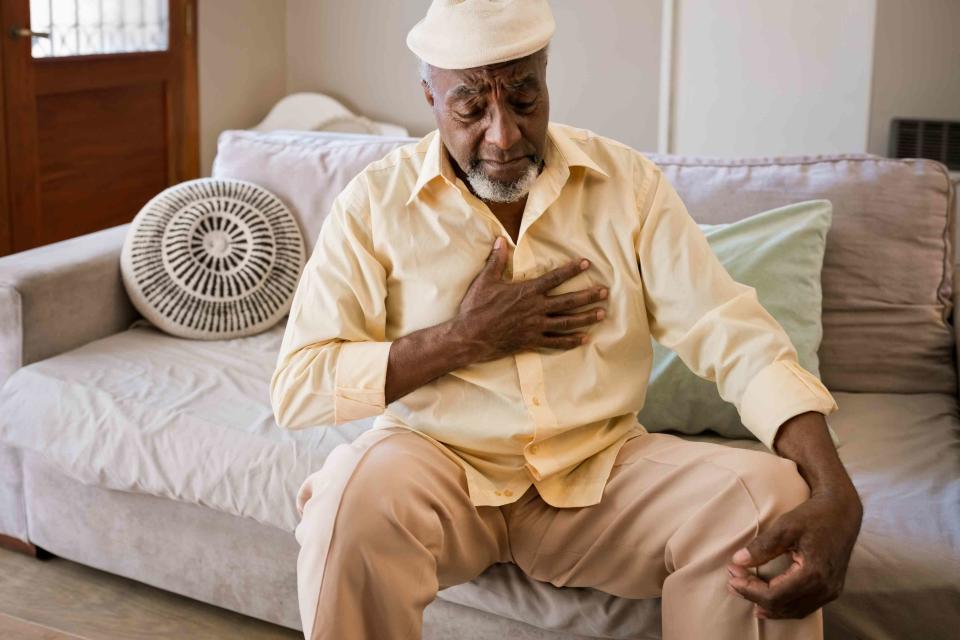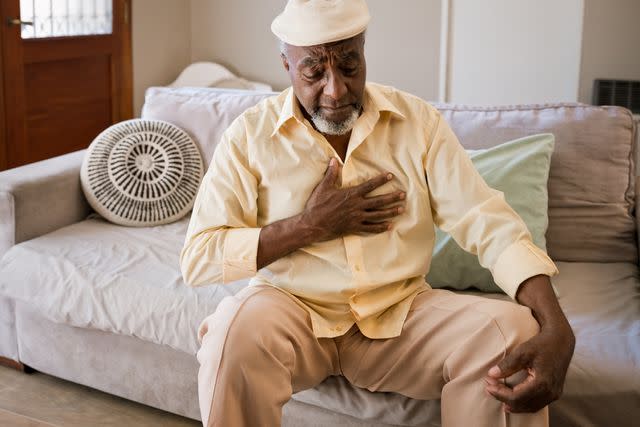When Is Pneumomediastinum (When Air Enters the Chest) Serious?
This Often Occurs After an Injury

izusek / Getty Images
A pneumomediastinum is a condition of air entering the chest. It often happens after an injury and causes chest pain. Many times it does not require medical intervention, but in cases in which the air is causing problems with the lungs or heart, medical attention is necessary.
This article will cover all the aspects of pneumomediastinum and discuss treatment options.

izusek / Getty Images
Pneumomediastinum: A Passing Air Bubble?
To fully understand pneumomediastinum it's helpful to break down the word:
"Pneumo" means "air" and refers to the lungs.
"Mediastinum" is the space inside the chest, between the lungs.
When put together, "pneumomediastinum" refers to a condition in which air moves outside the lungs or airways and into the chest. Simply put, it is an air bubble inside of the chest.
A pneumomediastinum is a rare occurrence. It is predominantly seen in men, with 76% of pneumomediastinum cases being in men.
A pneumomediastinum can be caused by a few different things. They include:
Traumatic injury: A significant physical injury like a car accident
Acute mediastinitis: Inflammation of the mediastinum (cavity that contains your heart and other vascular and nonvascular structures and organs) that usually occurs after chest surgery
Mechanical ventilation: Air that's being pushing into the lungs via a breathing tube, with high ventilator pressure causing the pneumomediastinum
Respiratory disease: Conditions like asthma, chronic obstructive pulmonary disease (COPD), and interstitial lung disease that cause excessive coughing
It can also happen for seemingly no reason at all. This is called a spontaneous pneumomediastinum.
When Is a Pneumomediastinum an Emergency?
A pneumomediastinum is an emergency when the trapped air compresses the lungs or heart enough to cause impairment of the heart or lungs.
There is no way to know for sure how much air has entered the chest until a healthcare provider does a chest X-ray or other imaging.
If you or someone you are with has difficulty breathing or has chest pain, call 911.
Describing Pneumomediastinum Pain
When an air bubble enters into the chest, it can cause sudden chest pain behind the sternum (breastbone) that extends to the neck and back. Other symptoms that someone might experience with a pneumomediastinum include:
Coughing
Neck pain
Vomiting
Fast heart rate
Anxiety
Subcutaneous emphysema is found in 70% of people with a pneumomediastinum. This is when air becomes trapped underneath the skin. It produces bumps under the skin and a crackling noise when the skin is touched.
Pneumomediastinum is diagnosed with a chest X-ray. In some cases, a healthcare provider may request a computed tomography (CT) scan or magnetic resonance imaging (MRI) to get clearer chest images to make their diagnosis.
Pneumomediastinum and COVID-19
Researchers have found that patients with COVID-19 who require mechanical ventilation develop a pneumomediastinum. COVID-19 can cause lung injury, which requires the patient to need a breathing tube. When the lung injury worsens, healthcare providers may need to increase the pressure from the ventilator. This increase in the ventilator can cause a pneumomediastinum.
Pneumomediastinum Relief: What to Do for a Lung Air Bubble
Pneumomediastinum treatment is aimed at relieving the symptoms. The condition typically does not require intensive medical treatment and has good outcomes for the patient.
Immediate pain relief will be accomplished with pain and antianxiety medications. Oxygen therapy serves to help the body reabsorb the air bubble.
Healthcare providers will work to relieve the underlying cause, like COPD or asthma, to prevent additional air bubbles.
If the pneumomediastinum is significant and the amount of air in the chest is affecting the heart or lungs, a mediastinal chest tube may be placed. This is a tube inserted into the chest that will allow the air to leave the chest.
Pneumomediastinum vs. Pneumopericardium
Pneumopericardium is when air enters the area around the heart and into the thin sac that surrounds the heart. This is a complication of air entering the chest with a pneumomediastinum and can impair the heart's ability to pump blood throughout the body properly.
Pneumomediastinum Watchful Waiting
A pneumomediastinum is rarely a life-threatening condition or an emergency. Healthcare providers often have people with pneumomediastinum stay in the hospital for 24 hours for observation after diagnosis. During this time, it is called watchful waiting.
Pneumomediastinum Hospitalization: Treatment for Collapsed Lung
A collapsed lung, also called a pneumothorax, is a separate condition from a pneumomediastinum, but they often happen simultaneously.
When someone has a collapsed lung, air escapes from the lung and fills the area between the lung and chest wall. This air outside of the lung pushes against it and causes it to collapse.
A small pneumothorax may go away without treatment. But a more significant pneumothorax will need to be treated in a hospital. The mainstay treatment is the placement of a chest tube in the area around the lungs and oxygen therapy. The chest tube will allow the air to leave the chest, and oxygen helps the air bubbles reabsorb into the body.
Pneumomediastinum Follow-Up and Ongoing Care
If you experience a pneumomediastinum, you will be asked to follow up with your healthcare provider after treatment. If an underlying condition caused the pneumomediastinum, then the healthcare provider will provide guidance to prevent recurrence.
If there was no known cause, the provider may suggest lung function tests to identify an underlying lung condition.
It is rare for a pneumomediastinum to recur and, as a result, long-term follow-up is not typically required.
Learn More: The 8 Most Common Types of Respiratory Disease
Summary
A pneumomediastinum is when air leaves the lungs or airways and gets trapped inside the chest. It can happen spontaneously for no known reason or can occur after an injury or from a respiratory condition. If the person with the pneumomediastinum is not severely affected by the air bubble, healthcare providers take a conservative approach to treatment. However, if the trapped air is causing problems, then the provider may perform a procedure to remove the air.

